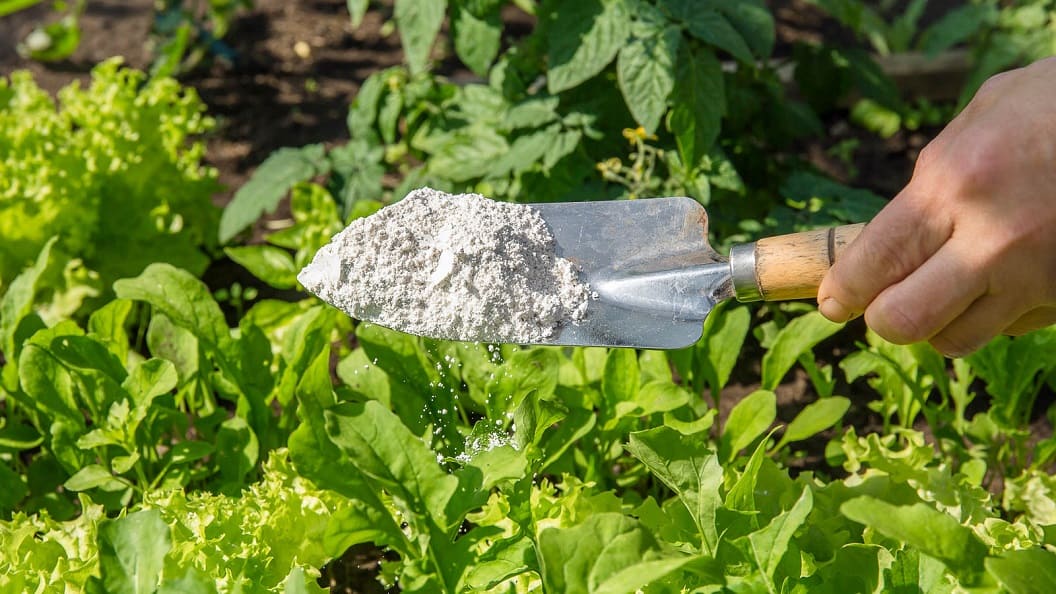Last week, I watched in horror as tiny aphids colonized my prize roses, and slugs turned my lettuce into Swiss cheese overnight. Sound familiar? If you’re tired of watching pests devour your hard work while avoiding harsh chemicals, it’s time to discover one of gardening’s best-kept secrets: diatomaceous earth.
Have you ever heard fellow gardeners mention “DE” with the same reverence usually reserved for heirloom seeds or compost tea? They’re talking about diatomaceous earth—a natural, non-toxic powder that can transform your pest control game without compromising your organic gardening principles.
By the end of this guide, you’ll understand exactly what diatomaceous earth is, how to use it safely and effectively, and why it might become your new favorite tool in the ongoing battle against garden pests. More importantly, you’ll learn how to protect beneficial insects while targeting the troublemakers.
What Exactly Is Diatomaceous Earth?
Diatomaceous earth (DE) reads like something from a science fiction novel, but it’s actually an ancient gift from our planet’s past. This fine, chalky powder consists of the fossilized remains of diatoms—microscopic aquatic organisms that lived millions of years ago in oceans and freshwater lakes.
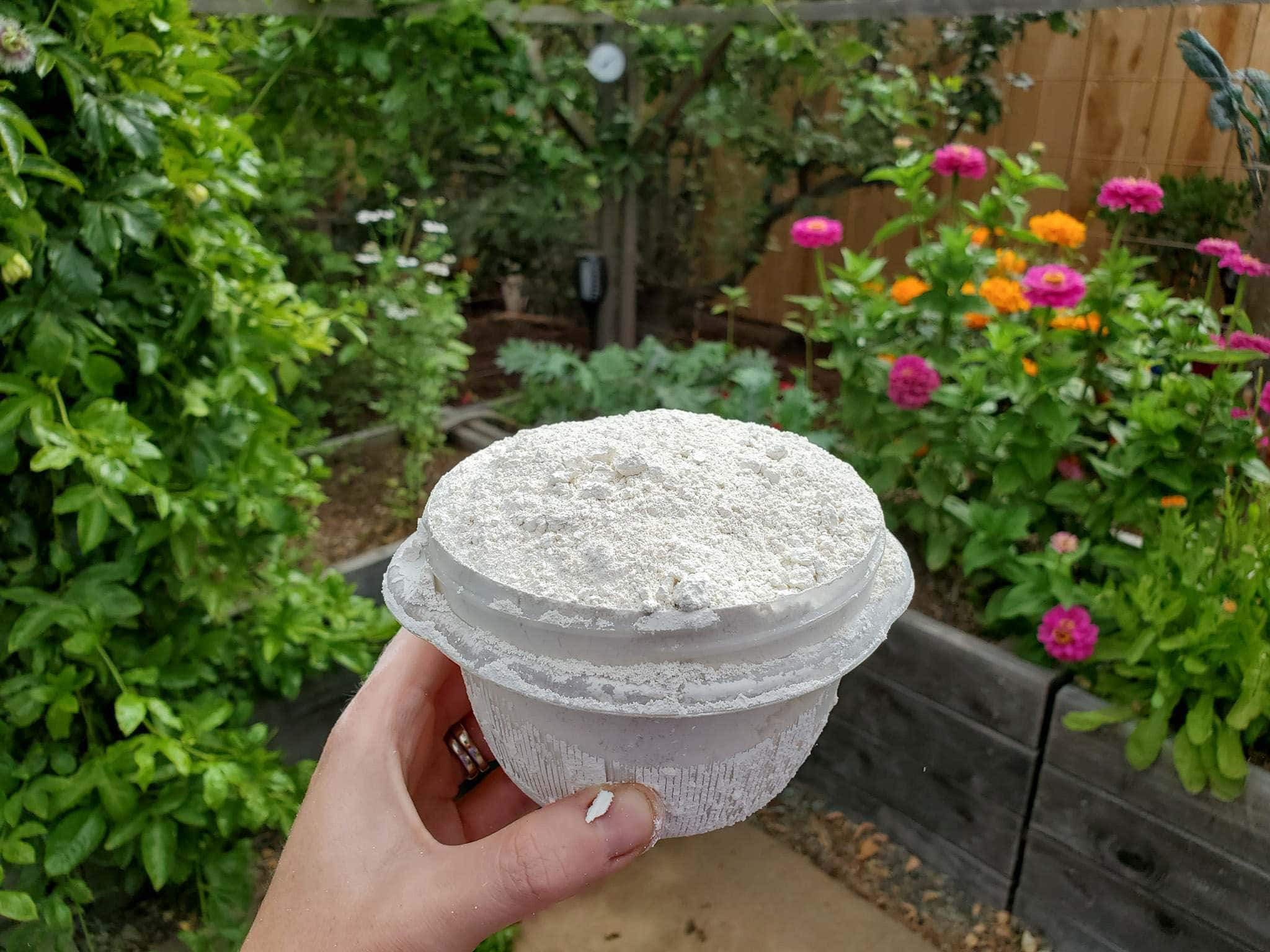
These tiny creatures built intricate, glass-like shells from silica, the same mineral found in sand and quartz. When they died, their shells accumulated on lake and ocean floors, eventually forming the sedimentary deposits we mine today as diatomaceous earth.
Under a microscope, these fossilized shells reveal an intricate structure with razor-sharp edges and countless tiny pores. To human hands, DE feels soft and powdery—almost like talcum powder. But for insects, it’s a deadly maze of microscopic glass shards.
The Science Behind the Magic: How DE Destroys Garden Pests
Diatomaceous earth works through pure mechanical action rather than chemical toxicity, which makes it both effective and environmentally responsible. When insects crawl through DE, two devastating processes occur simultaneously.
The microscopic sharp edges slice through the waxy coating that protects an insect’s exoskeleton—think of it as thousands of tiny razor blades creating wounds that compromise the bug’s protective armor.
Simultaneously, DE’s porous structure acts like countless microscopic sponges, absorbing the oils and fats from the insect’s damaged exoskeleton. This absorption accelerates dehydration, leading to death within 24-48 hours.
This mechanical approach means insects cannot develop resistance to DE the way they do with chemical pesticides—a major advantage for long-term garden health. Unlike synthetic pesticides that lose effectiveness as insects adapt, DE remains equally lethal year after year.
Your Pest Control Arsenal: What DE Can Tackle
Diatomaceous earth excels against crawling insects and soft-bodied pests, with research showing it can eliminate 80-90% of target pests within 24-48 hours of contact. However, effectiveness varies significantly by pest type.
- Highly Effective Targets: Ants, slugs, snails, earwigs, beetles, and cockroaches suffer severe damage from DE contact. These pests either avoid treated areas entirely or die quickly after exposure.
- Moderately Effective Targets: Aphids, spider mites, and thrips can be controlled with direct application, though multiple treatments are often necessary. These smaller pests may require the wet spray method for adequate coverage.
- Limited Effectiveness: Flying insects that don’t spend significant time crawling on surfaces, caterpillars with protective mucus layers, and hard-shelled beetles may show minimal response to DE treatment.
Understanding these effectiveness levels helps set realistic expectations and guides treatment decisions. For flying pests or those resistant to DE, consider integrating other organic control methods into your strategy.
The Critical Safety Distinction: Food-Grade vs. Filter-Grade
Not all diatomaceous earth is created equal, and using the wrong type can be dangerous. The difference goes beyond simple labeling—it’s a matter of safety and effectiveness.
Food-grade DE comes from freshwater sources and contains less than 1% crystalline silica. It’s safe for use around humans, pets, and food plants, often carrying OMRI certification for organic production. This type feels soft and powdery, with a white to off-white color.
Filter-grade (pool-grade) DE undergoes heat treatment at extremely high temperatures, converting silica into a crystalline form that’s toxic to mammals when inhaled. While effective for industrial filtration, it’s completely unsuitable for gardens and can cause serious respiratory damage.
The packaging should clearly state “food-grade”—if there’s any doubt about the type, don’t use it in your garden. Investing in quality food-grade DE from reputable suppliers ensures both safety and effectiveness.
Mastering Application: Techniques That Actually Work
Success with diatomaceous earth depends entirely on proper application timing, technique, and quantity. Here’s how to maximize effectiveness while protecting beneficial insects.
Understanding Application Rates
For dry applications, use approximately 1-2 pounds of DE per 1,000 square feet for general coverage, or about 1 tablespoon per square foot for targeted treatment around individual plants. Think “light snow dusting” rather than “heavy blanket”—insects need to contact the particles, but thick layers actually deter them from crossing treated areas.
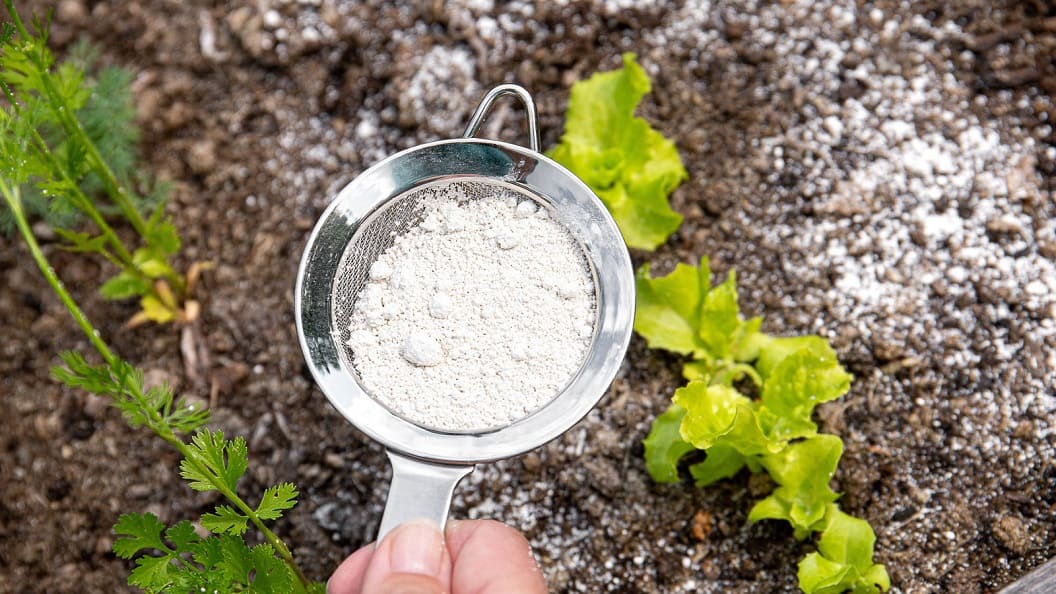
For wet applications, mix 4-6 tablespoons of DE per gallon of water. This ratio provides adequate particle density without clogging spray equipment. Always add water first, then gradually whisk in DE to prevent clumping.
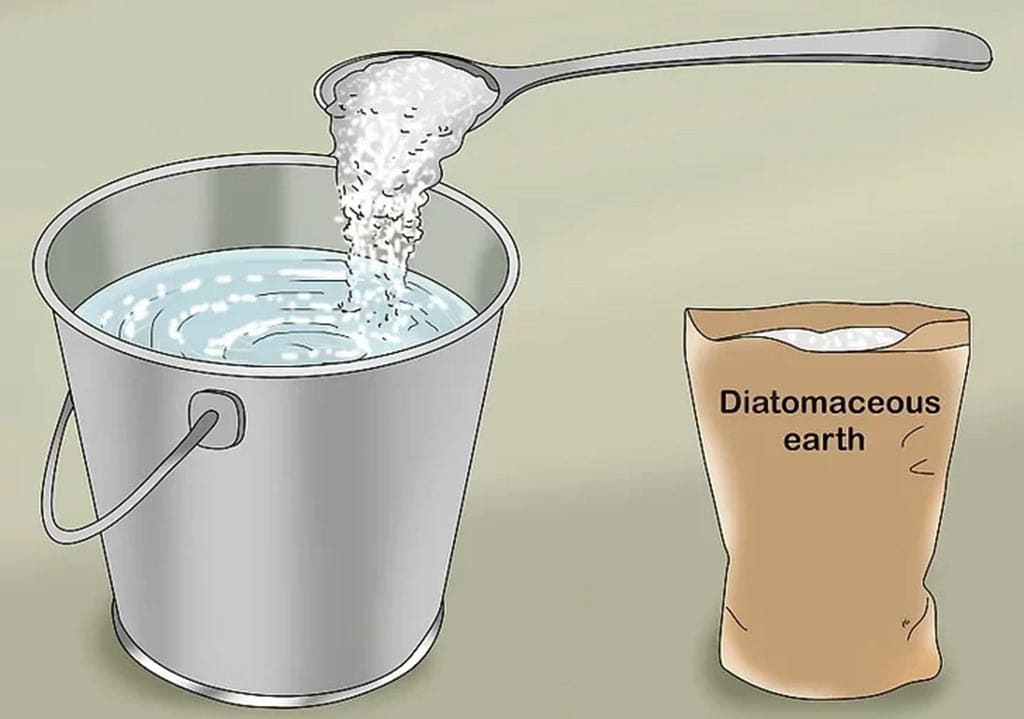
Timing Your Applications
Early morning or late evening applications work best for multiple reasons. Beneficial insects are less active during these periods, reducing accidental exposure. Morning dew helps dry applications adhere to plant surfaces, while cooler temperatures reduce evaporation rates for wet applications.
Seasonal timing matters too. Spring applications before pest populations explode provide the best prevention, while mid-season treatments require more frequent reapplication as pest pressure increases. Avoid applications during plant flowering periods when pollinators are most active.
The Dry Method
Apply dry DE using a flour sifter, garden duster, or repurposed spice shaker for even distribution. Focus on plant bases, soil surfaces where pests travel, and the undersides of leaves where many insects hide.
After light rain or heavy dew, plants remain slightly moist, helping DE particles stick to surfaces without creating airborne dust. Avoid application during windy conditions, which can blow particles onto non-target areas or reduce effectiveness through uneven coverage.
The Wet Spray Method
Mix your DE solution in small batches to prevent settling, shaking the sprayer every 30 seconds during application. Thoroughly coat affected areas, paying special attention to leaf undersides and soil-plant interfaces where pests congregate.
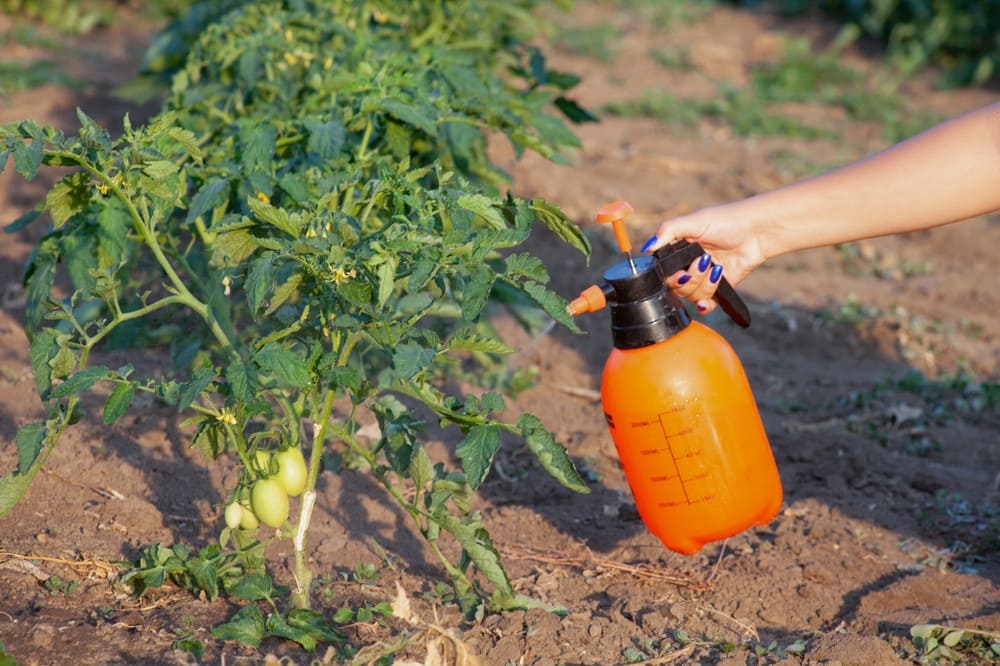
The insecticidal action begins only after water evaporates completely, typically within 2-4 hours depending on humidity and temperature. Plan applications when at least 6-8 hours of dry weather are forecast to ensure proper activation.
Beyond Pest Control: DE’s Hidden Garden Benefits
While pest control steals the spotlight, diatomaceous earth offers several additional advantages that enhance overall garden health.
When incorporated into soil at 10-15% by volume, DE improves drainage in heavy clay while helping sandy soils retain moisture. Its porous structure creates tiny air pockets that prevent compaction and improve root health. This dual action makes DE particularly valuable for container gardening and raised bed systems.
Plants absorb silica from DE, strengthening cell walls and improving drought resistance. This natural fortification creates a physical barrier that makes leaves harder for remaining pests to damage while improving overall plant resilience to environmental stresses.
In compost systems, DE absorbs excess moisture and reduces odors while deterring flies and maggots from establishing colonies. Add small amounts gradually—about 1 cup per cubic yard of compost material—to avoid disrupting beneficial decomposition processes.

👉 Here’s How to Compost Sawdust: Pro Tips, Ratios & Risks Explained
Environmental Responsibility and Limitations
Understanding DE’s environmental impact requires acknowledging both its benefits and limitations compared to synthetic alternatives.
Protecting Beneficial Insects
DE’s biggest environmental concern is its non-selective nature. Beneficial insects including bees, ladybugs, lacewings, and predatory beetles suffer the same fate as pests when they encounter DE particles.
Critical protection strategies include never applying DE to open flowers or areas where pollinators actively forage, timing applications for early morning or evening when beneficial insects are less active, and using targeted spot treatments rather than broad-spectrum applications.
Stop applications immediately once pest problems are controlled, allowing beneficial insect populations to recover and maintain natural pest control services.
Climate and Weather Considerations
DE’s effectiveness depends heavily on environmental conditions. High humidity regions require more frequent reapplication, while arid climates may see longer-lasting effectiveness. Frequent rainfall areas may find DE impractical due to constant washoff and reapplication needs.
Wind patterns also affect success rates. Consistent winds can blow away applications or redistribute particles to unintended areas. Consider these factors when deciding whether DE fits your local growing conditions.
Safety Protocols and Proper Handling
While food-grade DE poses minimal health risks, proper handling prevents unnecessary exposure and ensures effective application.
Respiratory protection remains essential when applying dry DE. Even food-grade versions can irritate lungs if inhaled in large quantities, particularly for individuals with asthma or other respiratory conditions. Use N95 masks or equivalent protection during application.
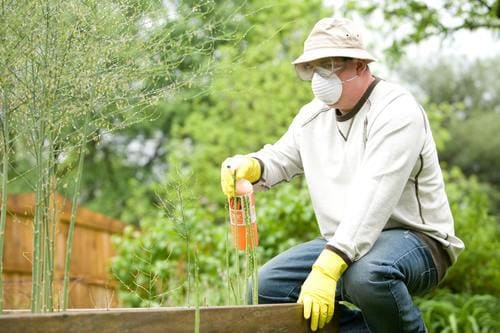
Eye protection prevents irritating particles from reaching sensitive tissues, while gloves protect hands from DE’s drying effects during extended handling. Work in well-ventilated areas and avoid creating dust clouds that might affect family members or pets.
Store DE in airtight containers in dry locations to maintain effectiveness indefinitely. Moisture causes clumping and reduces particle sharpness, diminishing insecticidal properties.
Integration with Other Garden Management Strategies
Diatomaceous earth works best as one component of a comprehensive integrated pest management approach rather than a standalone solution.
Combine DE barriers with companion planting strategies using pest-repelling plants like marigolds, basil, and nasturtiums. Physical barriers such as row covers and copper tape complement DE applications by providing additional protection layers.
DE can be safely combined with most organic treatments, though timing matters. Apply liquid treatments like insecticidal soap or neem oil first, allow them to dry completely, then apply DE as a protective barrier. This sequence prevents DE from interfering with liquid treatment effectiveness.
Create beneficial insect habitat away from DE-treated areas to maintain ecosystem balance. Native flowering plants, diverse vegetation, and pesticide-free zones provide refuge for natural pest control agents.
Troubleshooting Common Challenges
Understanding why DE sometimes fails helps optimize application strategies and set realistic expectations.
When DE seems ineffective, first verify you’re using food-grade material and that applications remain dry for 24-48 hours after treatment. Confirm target pests actually travel through treated areas—some insects may find alternate routes that bypass DE barriers.
If beneficial insect populations decline, reduce DE applications to problem areas only, avoid all flowering plants, and create larger untreated beneficial habitat nearby. Remember that ecosystem balance takes time to restore after disruption.
Frequent reapplication demands often indicate inappropriate pest targets or environmental conditions unsuitable for DE use. Consider whether alternative organic controls might be more practical for your specific situation.
Cost Considerations and Purchasing Guidance
Understanding DE costs helps budget for effective pest management programs. Food-grade DE typically costs $1-3 per pound, with bulk purchases offering better value. A 50-pound bag can treat a large garden for an entire season with proper application techniques.
Purchase from reputable garden centers, feed stores, or online suppliers that clearly label products as food-grade and provide OMRI certification for organic applications. Avoid purchasing from pool supply stores, which typically stock only filter-grade products.
Factor reapplication frequency into cost calculations. Gardens in high-rainfall areas may require weekly applications during peak pest season, while arid regions might need monthly treatments or less.
👉 Learn about Desert Gardening for Beginners: Growing Food & Plants in Extreme Heat
Signs of Success and When to Adjust Strategy
Recognizing DE effectiveness helps optimize application schedules and determine when alternative strategies might be necessary.
Successful DE applications show reduced pest damage within 3-5 days, with peak effectiveness at 7-10 days for crawling insects. Slug and snail damage should decrease noticeably within 48 hours as these pests avoid treated areas.
If pest populations don’t decline after two weeks of consistent applications, consider whether you’re targeting appropriate pests, using adequate quantities, or maintaining dry conditions long enough for effectiveness. Some situations may require switching to alternative organic controls or combining multiple treatment approaches.
Monitor beneficial insect populations alongside pest reductions. Healthy gardens maintain diverse insect communities with natural predator-prey relationships that provide long-term pest control without constant intervention.
The Bottom Line: Making the Right Choice for Your Garden
Diatomaceous earth offers garden pest control that bridges the gap between completely hands-off organic gardening and chemical-intensive approaches. It’s neither a miracle cure nor a dangerous threat—rather, it’s a powerful tool that demands respectful, informed use.
Choose DE when you need targeted control of crawling pests, chemical pesticides are off-limits in your garden, you can commit to proper application and reapplication schedules, and you’re willing to integrate it thoughtfully with beneficial insect protection.
Look elsewhere when your primary pests are flying insects or those that don’t contact soil surfaces, you garden in consistently wet climates where reapplication becomes impractical, or your garden hosts critical pollinator populations you cannot afford to risk.
Success with diatomaceous earth requires understanding both its remarkable capabilities and inherent limitations. When used appropriately as part of a comprehensive garden management strategy, DE can help create healthier, more productive gardens that work in harmony with natural systems rather than against them.
The goal isn’t a perfectly pest-free garden—that’s neither natural nor sustainable. Instead, aim for a balanced ecosystem where pest damage stays below acceptable thresholds while beneficial insects thrive and provide long-term pest control services.
